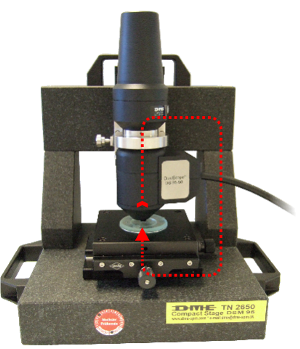- DME Channel on YouTube

The question about the stability of a stage and a total SPM set-up, respectively, may seem trivial: As much granite as possible, some vibration damping, and then a shielding box over the whole set-up, and then you have the best stability you could ask for..? Unfortunately, it is only nearly right.
The basic optimization possibility for an SPM system is through minimizing the mechanical route from the sample surface, through the stage, the scanner holder, the scanner housing and to the SPM Sensor (see illustration to the right) and use materials with the smallest possible expansion coefficients for these parts.
As an example, 2 cm aluminum will shrink / stretch 50 nm at a temperature change of 0.1°C, iron and minerals more than 20 nm, and invar, a special iron-nickel alloy app. 2 nm. Temperature changes this small will always occur in a system that is not thermally isolated. It is clear to see that for resolutions of below 1 nm, which almost any SPM microscope can achieve, a long mechanical route between sample and scanner tip may lead to the system being useless. For STM scanners which, because of their high resolution, need the highest stability, the sample is placed very close to the scanner housing, so that the mechanical route will only be a few cm, or even below one cm. Hereby, the influence of the thermal expansion as well as acoustic vibrations will be minimized. Often, to further minimize the temperature influence, load bearing parts in the scanner are made from the alloy invar (this is the case for our STM and AFM scanners).
A further optimization is to get the the highest possible resonance frequency for the whole system and to mechanically isolate the stage from the platform it is standing on. When the resonance frequency of the total system is very high, the disturbing low frequency noise is eliminated and at the same time the remaining higher frequencies are more easy to be damped. The only disturbing vibrations will be those originating from the scanner and sample oscillating against each other, which will result in the distance changes showing in the image. Also protruding constructions such as e.g. a long camera arm should be avoided, since such constructions will act as a microphone and will surely necessitate the use of further vibration isolation or equipment for acoustic damping.
It is easy to understand that the smallest possible scan platform is the best (naturally, the same applies to the scanner and sample as well). With our smallest "Igloo" it is possible to achieve atomic resolution on almost any stable desk. The same applies to the smallest granite stage for which the mechanical route is somewhat longer than for the "Igloo", but the sample manipulation is facilitated and the operation is easier. If larger samples are to be measured, one of the larger stages is a necessity. For the performance of long time scans such as e.g. comprehensive spectroscopy measurements in such a stage, in most cases special temperature stabilizing will be necessary. For a good construction, the acoustic vibrations from a larger stage will not lead to stronger disturbances than those from a smaller stage.